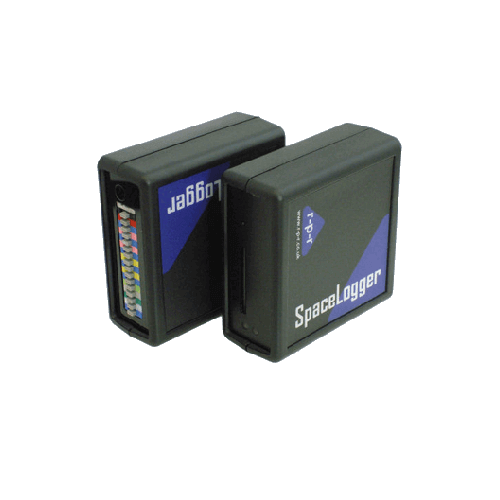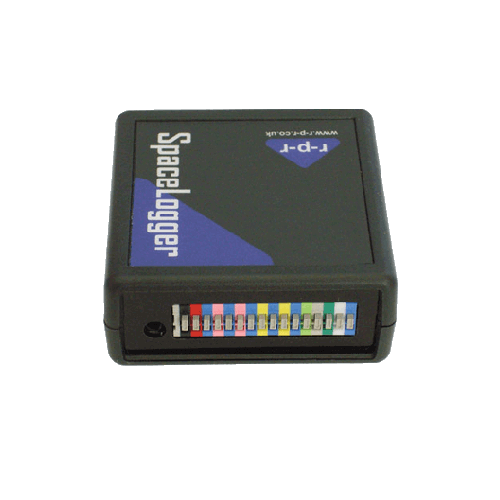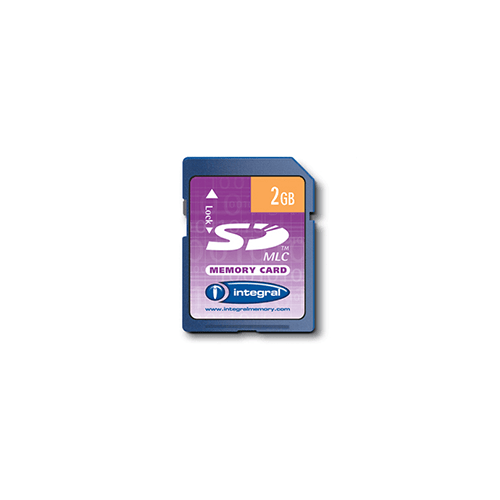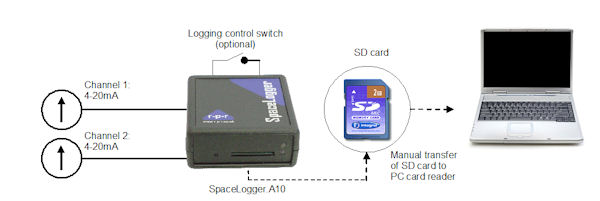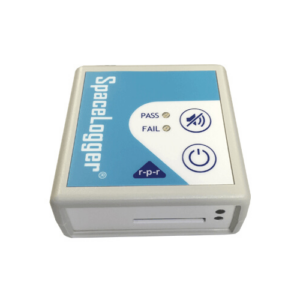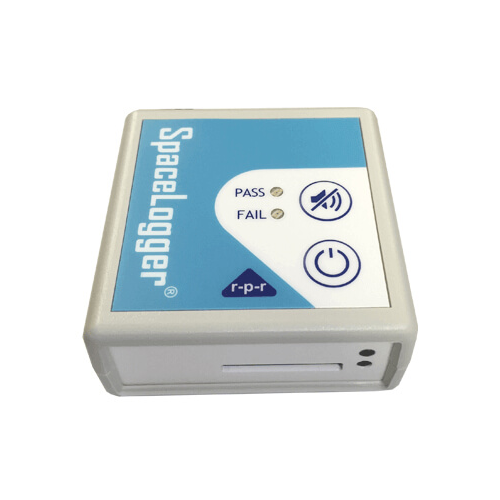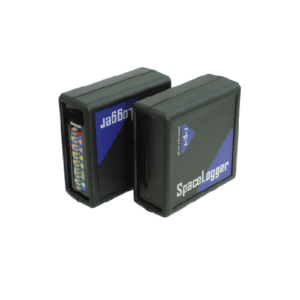A10 Analogue Logger
£174.96 exVAT
£209.95 incVAT
The SpaceLogger A10 Analogue is a versatile 2 channel 4 to 20 mA data logger.
• 2Gb Memory Card (included)
• Two 4 to 20 mA inputs, 10 bit resolution – allows logging from numerous sensors
• Data sampled and time-stamped then stored in daily files
• Simple to configure for wide range of applications – via setup file written to SD card
• Option to record status of a switch and RS232 data
• Conditional logging
• Alarm output signal
• Can be daisy chained to increase the number of channels
• Can be used to convert 4-20 mA to RS232 (with or without a memory card installed)
• SD card for high capacity data storage in easily removable and transferable format
• Compact, economical and robust design
• Low power consumption
• File format .CSV enables stored data to be read & analysed with standard PC software
Product Description
Overview
Data is stored on a removable memory card (included), enabling remote data logging without the need for direct connection to a PC. After logging, the memory card can be simply inserted in a card reader, to view and analyse the data on a PC; no special software is required.
Each data record can be date and time-stamped when it is stored. A new file is generated for each day’s data. The default file format is .CSV; other file extensions may be specified.
Data is stored as ASCII text with each record on a new line with comma separated fields. The available fields are: record prefix text, time & date, channel 1 reading, channel 1 units text, channel 2 reading, channel 2 units text, switch state.
Analogue values can be linearly scaled to convert to the units of the parameter being measured. Readings are sampled at 75 Hz and averaged over 1 sec.
In addition to the two analogue channels, the status of a switch input and data received on the logger’s RS232 input can be recorded. A comprehensive range of conditions for logging may be specified, which can be conditional on the analogue inputs, switch status or RS232 data.
RS232 data can be output and loggers daisy chained to increase the number of channels.
Customised versions and quantity discounts are available – please contact our sales team for a quote.
Logging Measured Values in Actual Units, Rather Than mA
The SpaceLogger A10 may be set to output a data string with measured values in any required units. The user may specify the units to appear in the logged data record with command UNITS1=”degrees”, for example.
It is necessary to set up the scaling factors to achieve readings in the required units over the measurement range from the measured current in mA.
Typical Applications
Scientific research
Education
Industrial automation
Plant and machinery monitoring
Quality control
Security monitoring
Environmental monitoring
SD Card Data Capacity
A typical string of data for each sample logged by the SpaceLogger A10 would be as follows:
Prefix, Date, Time, Channel 1, Units for Channel 1, Channel 2, Units for Channel 2, Switch State<CR><LF>
Where:
| Prefix: | text set by user – may be up to 10 characters long |
| Date: | format is DD/MM/YYYY (10 characters) |
| Time: | format is hh:mm:ss (8 characters) |
| Channel 1: | recorded value could be up to 16 characters max, including decimal point |
| Units 1: | text set by user – may be up to 10 characters long |
| Channel 2: | recorded value could be up to 16 characters max, including decimal point |
| Units 2: | text set by user – may be up to 10 characters long |
| Switch Sate: | logged as 0 or 1 (1 character) |
| <CR><LF>: | end of line is 2 characters |
Therefore, max number of characters in one sample is 90, i.e. 90 bytes (including the comma delimiters).
If logging a sample once per second, for one month this would be approximately 250 MB of data in total.
The following table gives the approximate capacity of the SD card, depending on the logging interval selected and the actual size of the data sample recorded:
SpaceLogger A10Data capacity by sample size and logging rate |
||||
| Memory Card Size | 90bytes @ 1 per sec |
90bytes @ 1 per 5 sec |
45bytes @ 1 per sec |
45bytes @ 1 per 5 sec |
| 2 GB | 8 months | >3 years | 16 months | >6 years |
Examples of SpaceLogger A10 Applications
Please read the Technical Note – A10 Application Examples for worked examples on using the SpaceLogger A10 in the following applications:
• Recording the level of water in a tank using an ultrasonic ranger
• Recording GPS data and two analogue channels
• Analogue to RS232 converter
• Push button triggered reading
• Logging the supply voltage
• Extending the number of analogue channels
| Physical | Enclosure dimensions | Width: 67 mm Depth: 67 mm Height: 28 mm (excluding optional rubber feet) |
| Weight | 75g | |
| Enclosure material | GP ABS (UL94-HB) plastic and acrylic | |
| Connections | Type | Screwless terminals capable of accepting wire 0.32 to 0.65mm diameter (AWG 28 to 22) |
| Analogue Input | Number of Channels | 2 |
| Range | 4 to 20 mA (0 to 23 mA maximum) | |
| Sampling | Readings are sampled at 75 Hz and averaged over 1 sec | |
| Maximum logging rate | 1 Hz | |
| Input impedance | 177 ohms | |
| Accuracy | ±1% or 0.1 mA at 20 °C over range 4 to 20 mA | |
| Drift with temperature | 100 ppm / °C over range -40 °C to +40 °C | |
| Analogue to digital converter | 10-bit resolution | |
| Switch Input | Digital channel | Input for logging control switch |
| Max input voltage | Must not exceed 3V | |
| Current out | 7μA max | |
| RS232 Input | Number of channels | 1 |
| Transmission standard | RS232 compatible, 8 bits and no parity | |
| Transmission speed | 9600 Baud (default) or selectable from 115200, 57600, 38400, 19200, 4800, 2400, 1200, 300 or 110 Baud | |
| Data sample | Records only the data between specified start (STX) and end (ETX) characters | |
| RS232 Output | Transmission standard | RS232 compatible, 8 bits and no parity |
| Transmission speed | 9600 Baud (default) or selectable from 115200, 57600, 38400, 19200, 4800, 2400, 1200, 300 or 110 Baud | |
| Output rate | Normal Mode: 1 data record per 1 to 60 seconds – selectable Single sample Mode: single data record output in response to event defined by command TRIGGER Slave Mode: rate determined by input of RS232 data sample defined by STX and ETX |
|
| Alarm Output | Min output voltage | VOH=1.7V Typ @ 1mA output current |
| Data Storage | Data storage card | Removable SD, MMC or MMC mobile card |
| Data capacity | 2 GByte (max) | |
| File system | FAT16 or FAT32 with 8.3 file names Sector size 512 Bytes |
|
| Data logging interval | Normal Mode: 1 data record per 1 to 60 seconds – selectable Single sample Mode: single data record logged in response to event defined by command TRIGGER with time delay defined by command DELAY Slave Mode: rate determined by input of RS232 data sample defined by STX and ETX |
|
| Audible / Visual Indicators |
LED indicators | Green: Ready to record data Red: Power on, Writing data to SD card |
| Audio bleeper | Two tone signal on correct card insertion Single tone when data purge button depressed Four bleeps per minute when time and date not set |
|
| Real Time Clock | Accuracy | ±40 ppm at 25°C |
| Backup battery | CR2032 | |
| Power | Power requirement | 7 to 30 V DC |
| Current at 12 VDC | 10 mA typical | |
| Supply input protection | Polarity reversal protected and internal resettable 140 mA fuse | |
| Connection options (both included) | 1.3 mm centre pin DC connector, or Screwless terminals (0.32 to 0.64 mm diameter, AWG 28 to 22 conductors) | |
| Environmental | Temperature range | Operating: -25°C to +70°C [or dependent on card conditions] Storage: -40°C to +70°C |
| Enclosure protection | IP203 | |
| EMC | EMC Directive 89/336/EEC – CE marked (Emissions: EN61326:1997 inc A1/A2/A3:2003, EN60945:1997 Immunity: EN61326:1997) FCC/CFR 47: Part 15:2004 |
The manufacturer reserves the right to amend the specification and therefore the information in this document may be subject to change.
| User Manual & Data Sheet | |
|---|---|
 |
SpaceLogger A10 – User Manual |
 |
SpaceLogger A10 – Data Sheet |
 |
A10 Application Examples – Technical Note |
